Village Montessori Blog
How to Teach Your Child to Read - or to do Anything

At Village Montessori, our curriculum includes the two methodologies of Montessori and Science of Reading (SOR) to foster independence, a love for learning and an ease of reading. These two methodologies go hand-in-hand because both methods are backed by science on how the brain learns.
We use a simple teaching technique called the Three-Period Lesson in our Montessori classrooms. You might also hear this called the gradual release of responsibility in SOR circles. You can use the Three-Period Lesson, or gradual release of responsibility, to help teach reading, as well as truly anything you want to teach your child.
First, the lesson needs to be modeled. Second, the lesson needs to be supported as your child works towards independence. Finally, your child needs opportunities to do the lesson independently.
Steps of the Three-Period Lesson:
- Modeling is the first period where you are simply showing your child how to do something - the introduction phase.
- Supporting is the second period when you do the lesson with your child and ask them to show you how to do the work while you assist - the recognition phase.
- Independence is the third period when you ask your child to do the lesson on their own - the comprehension phase.
The Three-Period Lesson in Action:
- Write various words on a sheet of paper and show your child - This word is cat, and it rhymes with rat.
- Ask your child - Show me the word that rhymes with cat (list rat among a few other word options from which they can choose).
- Ask your child - Can you make two rhyming words (out of a few word options from which they can choose).
- Progression through these three periods is progress towards your child's independence.
You may need to spend more time in period one and two before moving to period three. That’s OK. Allow ample opportunity for period one and two and your child will eventually want to take these steps independently.
The Three-Period Lesson can be summed up as - I do, we do, you do. Use this to teach everything from loading the dishwasher to learning to read to filling out a job application. Working side by side with your child until they master a skill will provide them with the confidence to tackle tasks independently and with confidence.
To learn more about our Top-Rated Preschool in Fort Mill, SC - as well as both our Montessori and Science of Reading curriculum - visit our website or schedule a tour to see our classrooms in action!
Lisa Sheen
Science of Reading Advocate & Founder of Village Montessori & Preparatory School
Creator of The Reading Brain Courses
#scienceofreadingofficial on IG
The Role of Learning Intervention Services in Early Childhood Education
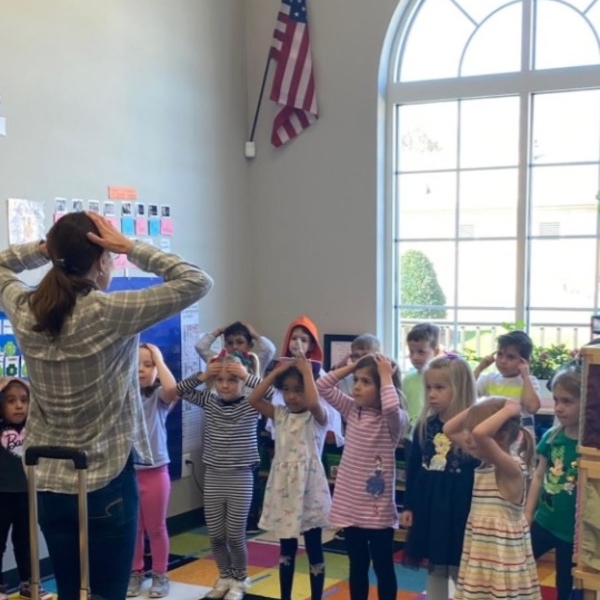
Early childhood education plays a vital role in shaping a child's cognitive, emotional, and social development. During these formative years, children absorb information at a rapid pace, and early educational experiences greatly influence their future learning path. Learning Intervention and Educational Services provide additional support for children who face challenges in meeting developmental milestones, ensuring they receive the right help at the right time. These services bridge potential learning gaps, fostering a positive relationship with education from an early age.
Key Benefits of Learning Intervention Services
Tailored intervention programs focus on individual learning needs, offering targeted solutions. Early detection of areas where a child struggles is essential to preventing these challenges from escalating over time. With proper learning support, children can overcome difficulties in areas such as literacy, motor skills, and language development. These services also promote self-confidence, helping children participate more actively in group activities and social settings.
Finding the Right Learning Environment
Families searching for the Best Preschools in Fort Mill often prioritize institutions that integrate learning intervention services. High-quality preschools combine early childhood education with structured support systems to help children thrive both academically and socially. This dual approach ensures children are prepared for early childhood education and beyond. Institutions that emphasize such services work closely with parents to monitor progress, set achievable goals, and make timely adjustments based on the child’s evolving needs.
Investing in early childhood education through Learning Intervention and Educational Services ensures children receive the necessary support to build a strong educational foundation. Selecting a preschool that integrates these services enhances the learning experience and nurtures well-rounded development. At Village Montessori, we are committed to providing the best possible care and educational support, empowering every child to succeed.
Why Montessori and How it Compares to Traditional Daycare
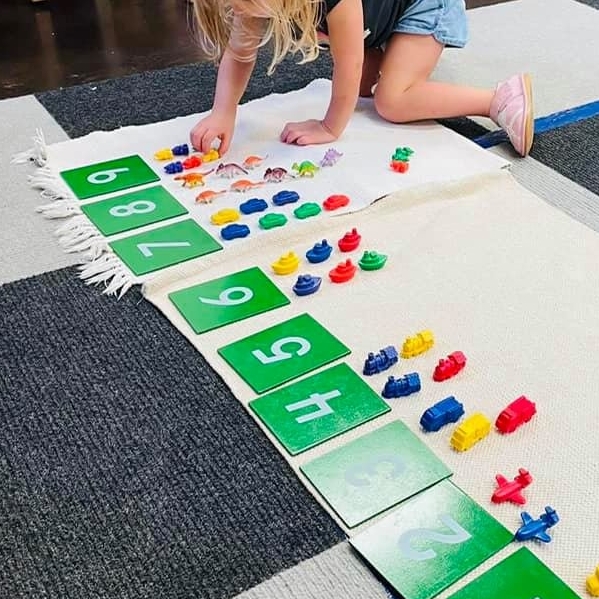
Choosing between traditional daycare and a Montessori education is simple when you consider how children’s brains learn, which is by explicit introduction of material, lots of repetition and hands-on learning that make tactile connections with the brain.
The Montessori approach stands out for its ability to foster independence and provide materials that extend beyond an age-specific curriculum. While traditional daycare provides supervision and group play, a Montessori environment nurtures a child’s natural inclination to learn by incorporating freedom of choice and movement.
Here’s a look at why the Montessori approach offers a richer educational experience for young children.
1. Concrete Learning: Engaging the Senses for Real Understanding
Montessori materials are designed to engage all senses, making learning more concrete and memorable. Unlike traditional daycare’s passive learning, Montessori activities encourage children to explore and manipulate materials that teach size, shape, color, and other essential concepts. This hands-on approach helps children build lasting knowledge through real-world connections.
2. Learning by Doing: Building Real-Life Skills
Montessori emphasizes practical, hands-on activities like pouring, buttoning, and tying that build fine motor skills and concentration. These tasks not only support everyday self-care skills but also foster self-confidence and independence. Traditional daycare often focuses on group play, but Montessori’s purposeful activities empower children to explore their individual abilities and interests.
3. Child-directed: Empowering Self-Learners
In Montessori, children choose their activities and manage their time within a structured environment, which nurtures independence and decision-making. Traditional daycare often centers on teacher-led activities, which can limit children’s ability to self-direct. Montessori’s child-centered approach allows kids to take charge of their learning once a lesson has been demonstrated to them, boosting confidence and resilience.
4. Mixed-Age Classrooms: Learning from Peers
Montessori’s mixed-age classrooms allow children of various ages to learn together, with younger children observing older peers and older children reinforcing their knowledge by helping younger ones. This arrangement encourages empathy, cooperation, and a sense of community that is harder to cultivate in traditional age-segregated daycare settings.
5. Small Class Sizes: Personalized Attention
Montessori classrooms are typically smaller, enabling teachers to give individualized attention to each child. This approach supports each child’s unique developmental path, allowing teachers to observe and guide their growth. Traditional daycares, with large numbers of children in classrooms, may not always be able to provide the same level of personalized support.
6. Grace and Courtesy: Social Skills for Life
Montessori classrooms emphasize grace and courtesy, teaching children how to interact respectfully and thoughtfully with others. Through daily practice, children learn manners, patience, and kindness, which builds emotional intelligence and prepares them for social interactions beyond the classroom.
7. Prepared, Orderly Environment: A Peaceful Space for Learning
Montessori classrooms are calm, organized, and designed to promote focus. Each item has a designated place, fostering a sense of responsibility and respect for the environment. This contrasts with many daycare settings, where toys and materials may not be as purposefully arranged. The order and beauty of a Montessori classroom create an ideal atmosphere for concentrated, joyful learning.
The Montessori approach offers a unique blend of self-directed learning, hands-on experiences, and structured social interaction. By choosing Montessori over traditional daycare, parents provide their children with an environment that supports growth in every dimension—academically, emotionally, and socially. Montessori not only nurtures essential skills but also builds a strong foundation for lifelong learning and personal development.
To experience the Montessori approach in action, and schedule a tour at one of the top-rated Montessori preschools in Fort Mill, visit Village Montessori & Preparatory School.
Practical Life Activities in the Prepared Classroom and at Home
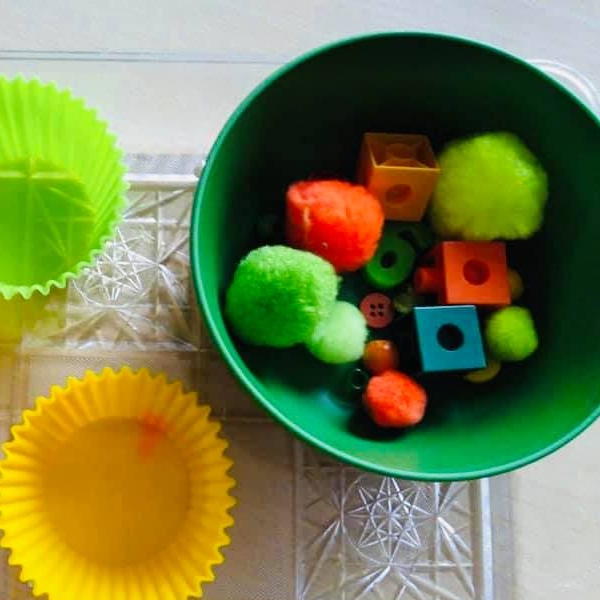
As Fort Mill’s top-rated Montessori school, Village Montessori & Preparatory School prides ourselves on creating a preschool and private kindergarten environment that provides a “whole child” approach to development: cognitive, spiritual, social, emotional and physical.
This development method allows for a dynamic prepared classroom environment that enables children of mixed age groups to explore a myriad of materials with differing levels of difficulty and learn as they are naturally inclined.
Whether in our infant room, preschool classrooms for 1-4 year olds, transitional kindergarten or private kindergarten, we emphasize and teach the whole child approach as developed by Maria Montessori.
In this blog we will be focusing on the Practical Life Area of our prepared classrooms and sharing ideas about how parents can create similar prepared learning environments in your own homes.
Practical Life Activities in the Prepared Classroom
The purpose of the Practical Life Activities in our prepared classrooms is two-fold:
- The prepared activities are meant to assist children in developing social skills and personal independence. Children learn to respect and take care of themselves and their environment and, in doing so, to respect and take care of others.
- The second purpose is to develop a child’s gross and fine motor movement, providing the foundation for every other facet of the learning environment.
Practical Life Activities are designed to encourage competencies in the following categories:
- Preliminary Activities
- Care and Respect for Self
- Care and Respect for the Environment
- Social Grace and Courtesy
- Fine Motor Skills
- Life Skills
All Practical Life Activities are uniquely purposeful and calming, and may appear simple and repetitive. However, if you were to observe a child as they perform such activities, you would notice:
- A high level of concentration - working on an activity for an extended period of time
- A developing sense of order - completing activities methodically from start to finish
- Pride in their work - showing you their completed work and/or demonstrating it for you
- Taking responsibility for any necessary cleaning - putting materials back where they belong in the classroom
- An increasing sense of independence - self-selecting activities and completing them independently
Practical Life Activities at Home
While the introduction to these Practical Life Activities may begin in our preschool and kindergarten classrooms, they are easily replicated at home. We invite you to try some of these fun, easy to set up activities and encourage your children to continue building their practical life activities in your own environment.
The following activities will help children work on their fine motor skills, color and shape recognition, and stimulate their senses:
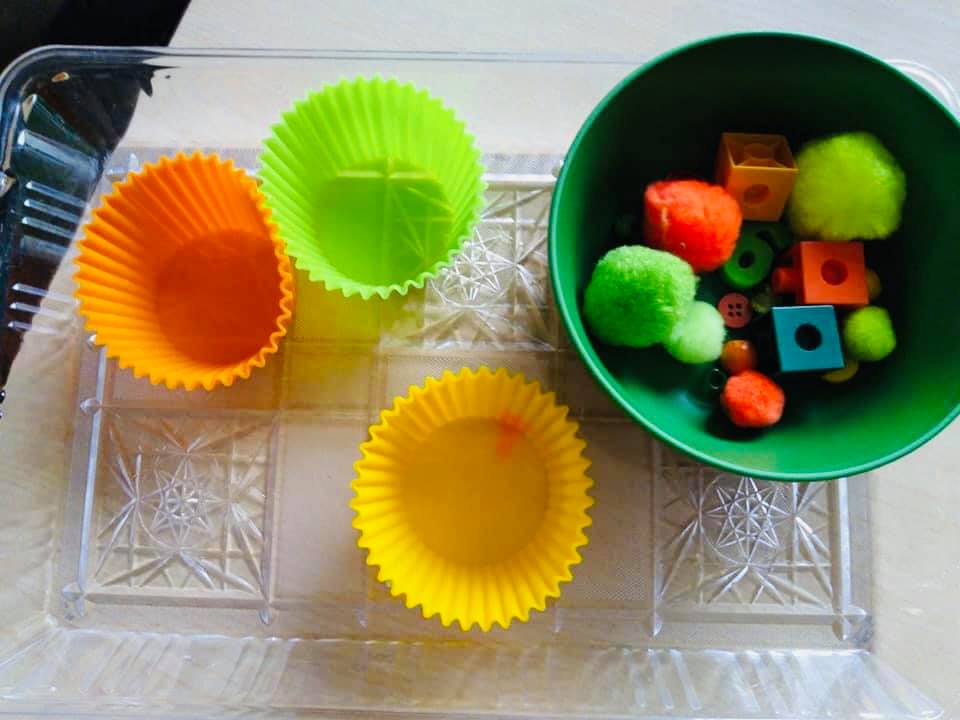 Sorting: Gather small cupcake liners, cups or bowls in a few colors. In a larger bowl, add a variety of small toys, balls, art supplies, etc. that match those same colors. Encourage your child to sort the items into the matching colored cupcake liner, etc.
Sorting: Gather small cupcake liners, cups or bowls in a few colors. In a larger bowl, add a variety of small toys, balls, art supplies, etc. that match those same colors. Encourage your child to sort the items into the matching colored cupcake liner, etc.
T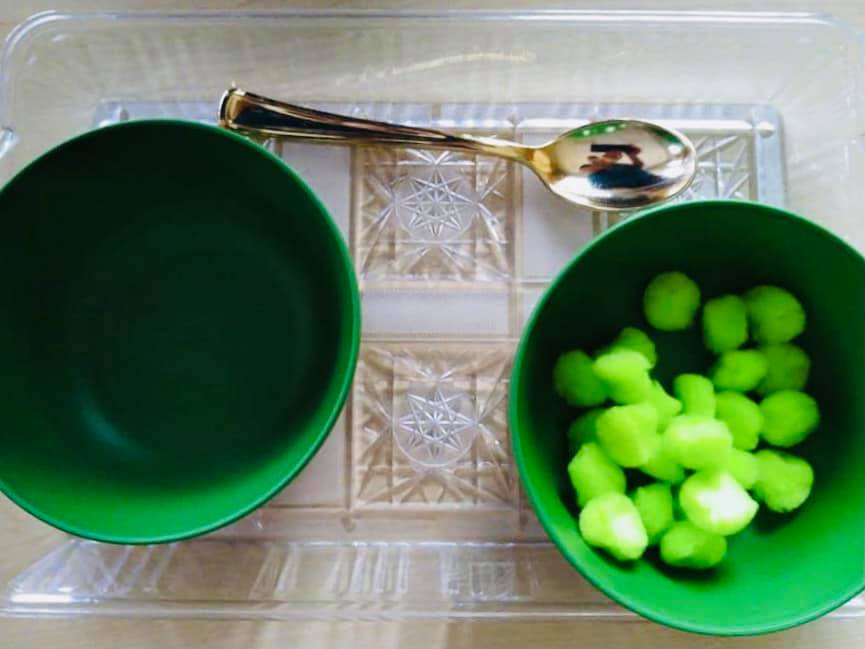 ransferring: Get two small bowls or containers. Add beads, puff balls, any small items easy to scoop with a spoon. Encourage your child to transfer the items using the spoon from one bowl to the other. You can also do this activity with small tongs.
ransferring: Get two small bowls or containers. Add beads, puff balls, any small items easy to scoop with a spoon. Encourage your child to transfer the items using the spoon from one bowl to the other. You can also do this activity with small tongs.
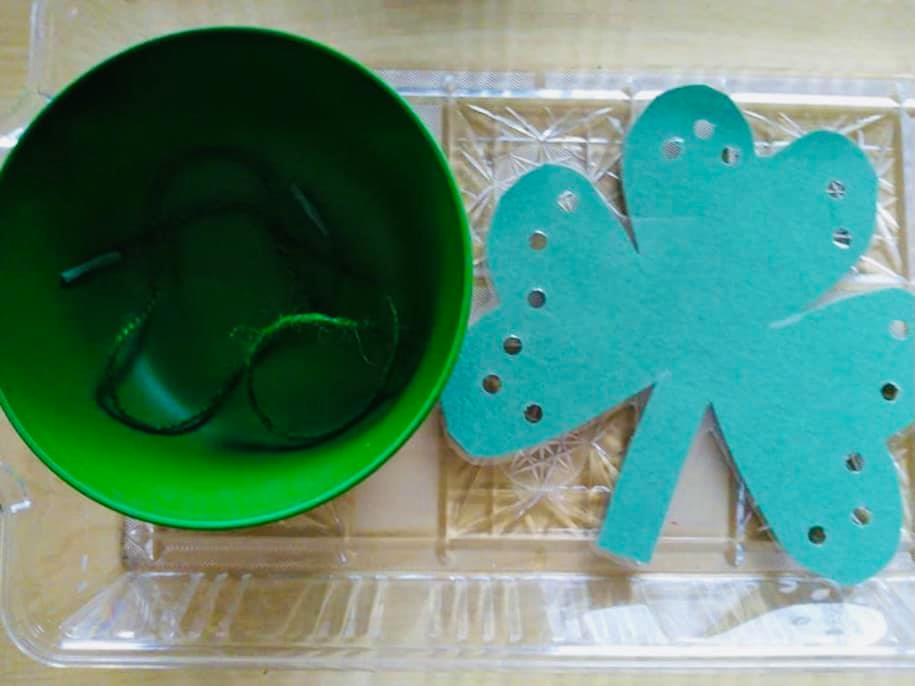 Lacing: Cut out a shamrock, or another fun shape such as a heart, circle, or square, and punch holes around the perimeter. Provide a shoelace or ribbon for your child and show them how to lace/weave the shoelace in and out of the punched holes.
Lacing: Cut out a shamrock, or another fun shape such as a heart, circle, or square, and punch holes around the perimeter. Provide a shoelace or ribbon for your child and show them how to lace/weave the shoelace in and out of the punched holes.
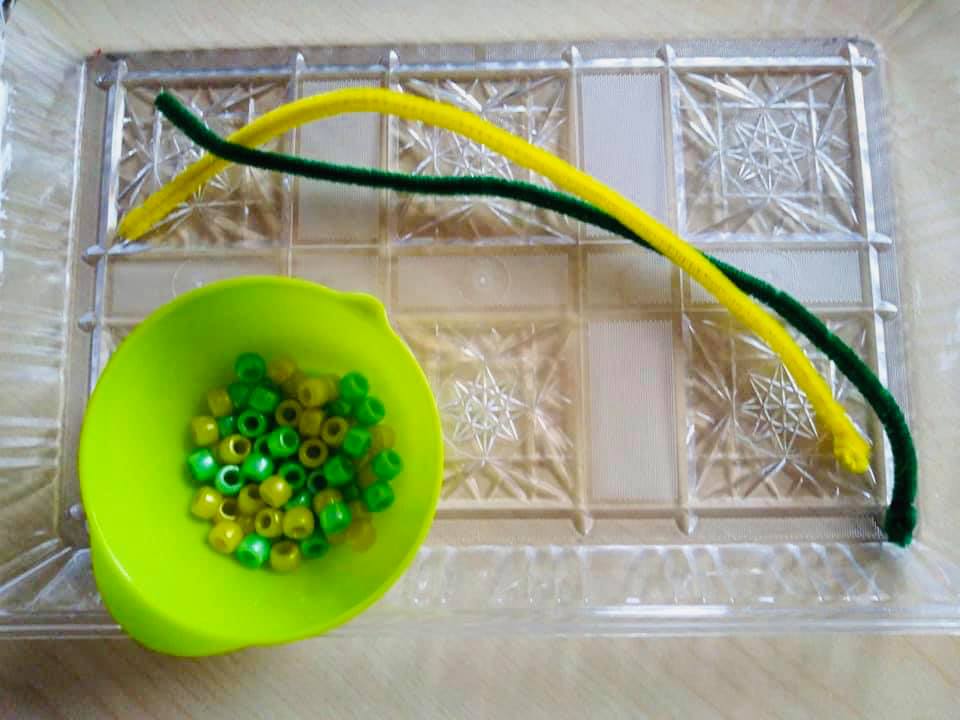 Bead Work: Add small beads in a variety of colors to a small bowl. Provide your child with a few pipe cleaners. Show them how to thread the pipe cleaner through the beads to create a pattern, a bracelet or a necklace. They can repeat the activity over and over again creating different patterns with the beads.
Bead Work: Add small beads in a variety of colors to a small bowl. Provide your child with a few pipe cleaners. Show them how to thread the pipe cleaner through the beads to create a pattern, a bracelet or a necklace. They can repeat the activity over and over again creating different patterns with the beads.
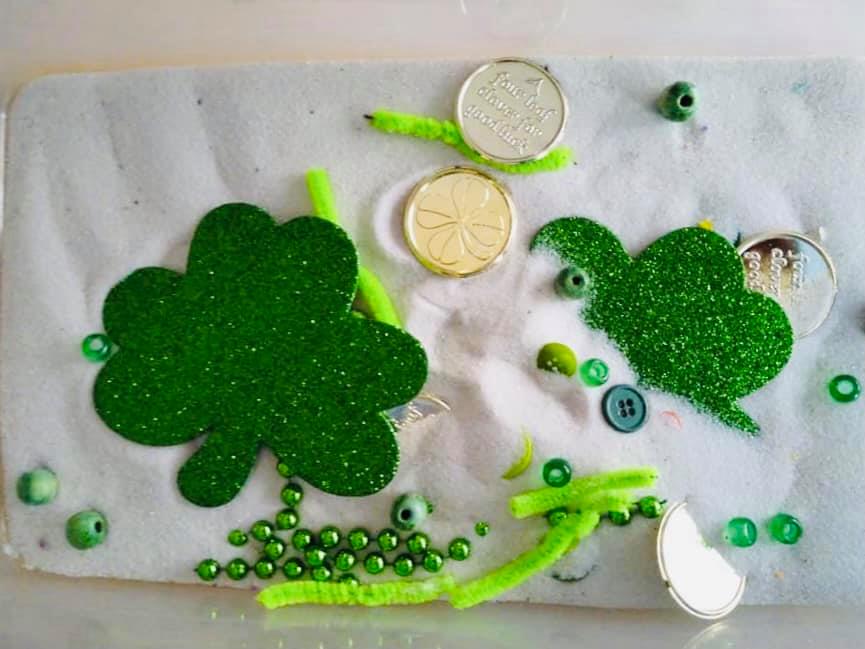 Sensory Bins: In a large bowl or plastic storage container add rice, beans, or sand (if you are brave!) and a variety of themed items such as small toys, plastic coins, buttons, beads, figurines, etc. Invite your child to find the items, scoop them out into smaller containers, arrange them in patterns, sort them, etc.
Sensory Bins: In a large bowl or plastic storage container add rice, beans, or sand (if you are brave!) and a variety of themed items such as small toys, plastic coins, buttons, beads, figurines, etc. Invite your child to find the items, scoop them out into smaller containers, arrange them in patterns, sort them, etc.
We hope you enjoy these ideas and creative ways to stimulate your child’s senses and fine motor skills at home!
To learn more about our Prepared Classrooms and Montessori Curriculum, we invite you to Schedule a Tour to visit our Fort Mill, SC location. We would love the opportunity to show you our school in motion!
Interactive & Manipulative Preschool Activities to Do with Your Child at Home
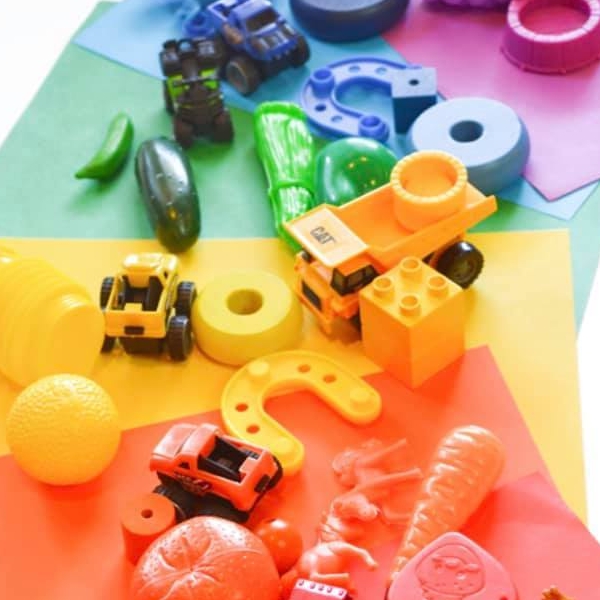
Interactive & manipulative preschool activities to do with your child at home
A great way to engage your preschooler at home is to create activities that build upon skills they’re learning in their classrooms - sensory bins, water work, sorting, and tracing, among others.
We’ve shared a few ideas below that we use in the Village Montessori & Preparatory School preschool classrooms and can be easily replicated at home.
Pouring Water Activities
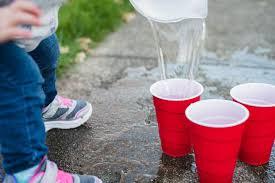
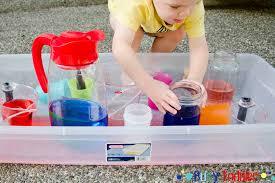
Pouring water activities allow children to finesse their fine motor skills, sense of measurement and depth, and eventually learn to pour water and drinks for themselves.
At school, we do this on small trays to catch overflow and splashes. At home, you could do this outside, in a sink, or on a baking pan.
Simply fill small cups with water (it’s fun to color it slightly too with food coloring) and provide different sized containers to transfer the water. Your children can learn to pour from containers that are the same sizes or learn that some sizes require different amounts of water to be filled and emptied.
When they are done, invite them to help empty all the containers, wash/dry them, and put the items away until they want to use them again.
Sorting Items By Color
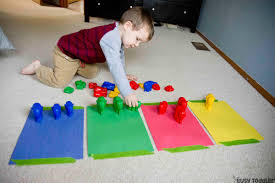
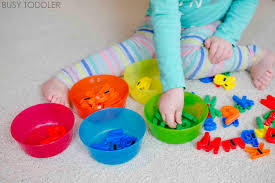
Sorting items by color helps your child develop the ability to recognize colors, color gradients, comparison, difference, and order.
Simply gather items from your home and place them in a box or on a pan. A mix of items creates an interesting array to sort.
Invite your child to choose one at a time and begin to sort them by color. They can place them in colored bowls, boxes or even on brightly colored paper that matches the colors of the items.
You can evolve this activity into sorting items by size, shape, use, where they are found in the house, etc. Or invite your child to create their own categories to sort from what has been gathered.
When they are done sorting items, invite them to help put items back and clean up!
Tracing Letters & Numbers
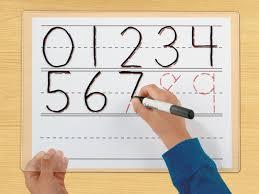
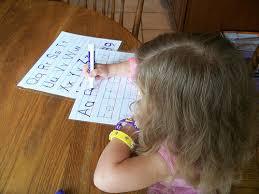
In our classrooms, children utilize a number of different materials to build literacy, letter and number recognition, and strengthen their fine motor skills.
One activity that is simple to replicate at home is having your child trace their name, letters, numbers, lines, and even pictures or coloring sheets. Not only does it help them develop their recognition, but it also helps develop hand control, their pincer grasp, and their ability to ultimately string letters together into words.
To do this activity you can print number and letter sheets, coloring pages, or a document with their name on it and slip them into a clear sheet protector. Choose colorful dry-erase markers for them to use and a small cloth for them to clean their surface between uses.
If you don't have clear sheet protectors you may also simply have them trace items with colorful crayons or markers.
To learn more about our Classroom Activities and Montessori Curriculum, we invite you to Schedule a Tour to visit our Fort Mill, SC location. We would love the opportunity to show you our school in motion!
The Unique Super Powers of a Child with ADD/ADHD

Oftentimes, teachers are challenged by the exceptional students in their classrooms. These exceptionalities come in many forms. One of the more common differences you may see is a child with ADD/ADHD.
These students may require extra effort on the part of the teacher to adapt to their learning style and help them thrive in the classroom. It is my experience that children with ADD/ADHD also contribute many new and exciting opportunities to the classroom.
I like to tell children with any learning difference they have a "super power" and are all gifted by God to be exactly who He needs them to be.
Sometimes those gifts are energy and creativity that can challenge the "normal" classroom. That same energy and creativity can yield something innovative in the future they might contribute to. By not always seeing things the same way their peers do, these exceptional students add a different lens and way of seeing the world.
Instilling grit and perseverance to match the energy of these gifted students is one of the best things we can do for them as educators. We should strive to help them learn who they are, highlight their unique gifts, and focus on the flavor they add to the environments around them.
As teachers, we have the duty to empower these children and the opportunity to witness them bloom into learners that can succeed and thrive in any environment.
The following article below outlines the gift of having these dynamic children in the classroom: Why I Love Teaching Kids with ADHD.
-----------------
If you are exploring Learning Intervention Services or Educational Support for your child, we invite you to learn about the programs we have at Village Montessori & Preparatory School in Fort Mill, SC. We offer both individual and small group services after school between 3:00 - 6:00 pm.
We also offer specific programs for elementary school students in the areas of literacy and math: Elementary School Literacy Leaders (Tuesdays from 3:00-4:00 pm) and Elementary School Math Masters (Thursdays from 3:00-4:00 pm).
All services are provided by Mrs. Stacy Atkinson, VMPS Education Director & Learning Interventionist. Mrs. Atkinson holds an M.Ed. in Exceptional Student Education with a concentration in Educational Therapy. She is also a licensed Educational Therapist and her training is accredited by the International Dyslexia Association. Mrs. Atkinson has experience working with preschoolers up to college aged students as an academic coach, tutor and educational therapist.
- By Mrs. Stacy Atkinson - VMPS Education Director & Learning Interventionist
